

Habitat - Blobfish. Russell's viper. Russell's viper (Daboia russelli) in a sensing moment Daboia russelli is commonly known as Russell's viper and chain viper, among other names.[6][7] Description[edit] Russell's viper in Pune Zoo D. russelii can grow to a maximum length (body + tail) of 166 cm (5.5 ft) and averages about 120 cm (4 ft) on mainland Asian populations.
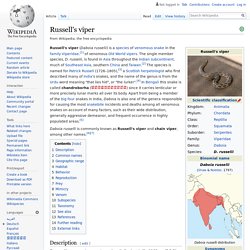
Island populations may be slightly smaller on average.[6] It is more slender than most vipers.[8] Ditmars (1937) reported the following dimensions for a "fair-sized adult specimen":[9] What Is the Natural Habitat of a Hedgehog? Hedgehogs are omnivores found naturally throughout Europe, Africa and Asia.
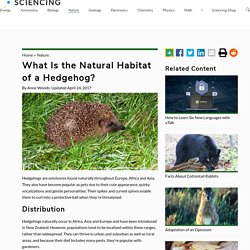
They also have become popular as pets due to their cute appearance, quirky vocalizations and gentle personalities. Their spikes and curved spines enable them to curl into a protective ball when they're threatened. Distribution Hedgehogs naturally occur in Africa, Asia and Europe and have been introduced in New Zealand. Notice Nature - October Species of the Month. Below is a list of our previous 'Species of the Month' The Hedgehog – An Gráinneog (Erinaceus europaeus) The hedgehog is a familiar species in the Irish countryside.
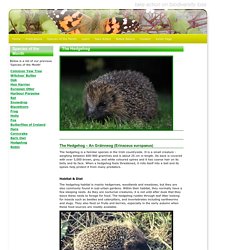
It is a small creature - weighing between 600-900 grammes and is about 25 cm in length. Its back is covered with over 5,000 brown, grey, and white coloured spines and it has coarse hair on its belly and its face. When a hedgehog feels threatened, it rolls itself into a ball and its spines help protect it from many predators. Dolphin Life Cycle.
The Life Cycle of Bottlenose Dolphins. Like coffee cup kittens, musical hamsters and cute bouncing babies, bottlenose dolphins, with their permanently etched "smiles" and playful antics, bring laughter and warmth to people around the world.
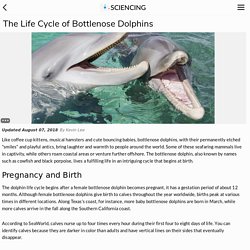
Some of these seafaring mammals live in captivity, while others roam coastal areas or venture further offshore. The bottlenose dolphin, also known by names such as cowfish and black porpoise, lives a fulfilling life in an intriguing cycle that begins at birth. Pregnancy and Birth The dolphin life cycle begins after a female bottlenose dolphin becomes pregnant, it has a gestation period of about 12 months. Although female bottlenose dolphins give birth to calves throughout the year worldwide, births peak at various times in different locations. According to SeaWorld, calves nurse up to four times every hour during their first four to eight days of life. Adult Bottlenose Dolphin Feeding.
Bottlenose Dolphin. Body Parts of a Fox. Foxes are one of nature’s most beautiful predators.

Native to many parts of the world including the United States, Canada, Europe and Asia, foxes are found in almost any country and in almost every environment. Extremely astute predators with very sharp senses, these animals possess impressive cognitive abilities that only add to their already mysterious reputation. Despite the differences between breeds such as the red fox, arctic foxes and fennec foxes, the general anatomy of the fox remains largely unchanged across the various breeds. Overall Characteristics Red foxes, as the name suggests, are usually a brownish red (though their coats may contain white, black and other shades as well.) In photos: Anatomy of a black mamba. Black mambas have a pretty bad rap.

Shrouded in myth and misinformation, the species is widely feared across much of southern Africa for its potent venom and alleged aggressiveness. Mamba. Mamba. Behaviour[edit] The three species of snakes are→→→§ green mambas are arboreal, whereas the black mamba is largely terrestrial.
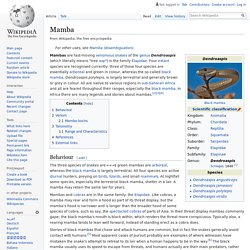
All four species are active diurnal hunters, preying on birds, lizards, and small mammals. Red Lionfish - Interesting Fishes of the Gulf of Mexico and Coastal Mississippi. June 23, 2014 - AL.Com - More Lionfish off Florida and Louisiana Than off Alabama, but There are Plenty Here, Alex Fogg was interviewed by Ben Raines regarding lionfish in the northern Gulf.
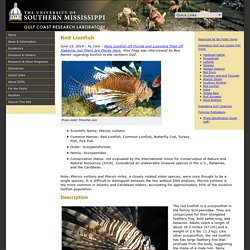
Photo credit: Primofish.com Scientific Name: Pterois volitans Common Names: Red Lionfish, Common Lionfish, Butterfly Cod, Turkey Fish, Fire Fish Order: Scorpaeniformes Family: Scorpaenidae Conservation status: not evaluated by the International Union for Conservation of Nature and Natural Resources (IUCN). Considered an undesirable invasive species in the U.S., Bahamas, and the Caribbean. Note: Pterois volitans and Pterois miles, a closely related sister species, were once thought to be a single species. It is difficult to distinguish between the two without DNA analysis.
Description. Invasive Species, Sting, 11 facts about blue whales, the largest animals ever known to live on Earth. So colossal are these majestic marine mammals, their hearts alone weigh as much as a car.

Picture in your mind a 10-story-tall animal walking down the street and you probably start channeling images of Godzilla or King Kong. But if you imagine it as a marine mammal and place it on its side, swimming … now you’ve got a blue whale. Balaenoptera musculus, the blue whale, is the largest animal ever known to have lived on the planet – movie monsters aside.
Facts, Habitat, & Pictures. Blue Whale (Atlantic population) SARA Status No Status NS Special Concern SC Threatened TH Endangered EN Extirpated EX COSEWIC Status Not at Risk NR Special Concern SC Threatened TH Endangered EN Extirpated EX Description.
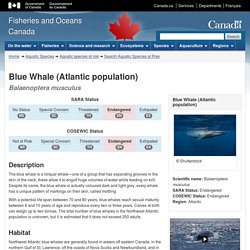
Spotted Salamander. Spotted Salamander. Reptiles & Amphibians in Ontario. Spotted salamander. Description[edit] The spotted salamander is about 15–25 cm (5.9–9.8 in) long.[6] They are stout, like most mole salamanders, and have wide snouts.[2] The spotted salamander's main color is black, but can sometimes be a blueish-black, dark grey, dark green, or even dark brown. Two uneven rows of yellowish-orange spots run from the top of the head (near the eyes) to the tip of the tail. The spotted salamander's spots near the top of its head are more orange, while the spots on the rest of its body are more yellow. The underside of the spotted salamander is slate gray and pink. Behavior[edit] Reptiles and Snakes. Vital Statistics Name. Myths, facts and more about the Black Mamba... Black Mamba.
Fennec Fox (Vulpes Zerda) - Animals. Fennec Fox Location Map of Africa Fennec Fox Fennec Fox Classification and EvolutionThe fennec fox is a small species of fox found in the deserts of North Africa. They are the smallest canine species but have the largest ears relative to their body size which are used to both aid their hearing and to help them to control their body temperature in the hostile environments in which they live. Fennec Fox - Key Facts, Information & Pictures. Image Source The Fennec Fox (Vulpes zerda) is a small canid which is native to the deserts of North Africa. It is the smallest of the canines but has the largest ears in proportion to its body size. Fennec foxes are found in North Africa from Morocco to Egypt, south to north Niger and Sudan, east to Sinai Peninsula and Kuwait. Fennec Fox Life Cycle by Quinn Mamula on Prezi. Russell's viper. The Life Cycle of a Pit Viper.
Northern pacific rattlesnake image by toschphoto from Fotolia.com. National Geographic. Barn Owl facts - All you need to know about Barn Owls. Barn Owl facts and fun for kids - The Barn Owl Trust. Barn Owl facts for kids – and lots of fun stuff too! Do you love Barn Owls? Fun facts about Barn Owls for kids. Barn Owls - 10 Facts About Me.
Common barn owl. The Common barn owl is penas alba, a species of owl in the genus Tito. It is the most widely distributed species of owl, and one of the most widespread of all birds. The barn-owl family Tytonidae is one of two main lineages of living owls, the other being the typical owls (Strigidae). Blobfish Facts. The World's Ugliest Animal. In Defense of the Blobfish: Why the "World's Ugliest Animal" Isn't as Ugly as You Think It Is. Blobfish — 10 Facts about the Kings and Queens of Ugly. Blobfish. Blobfish are typically shorter than 30 cm. They live at depths between 600 and 1,200 m (2,000 and 3,900 ft) where the pressure is several dozen times higher than at sea level.
National Geographic. Description, Behaviour, Venom, National Geographic. Black Mamba Facts. The black mamba has quite a reputation. Black mamba. Beautiful and Venomous Belcher's Sea Snake. The sea harbors many creatures that usually will not cause any danger to people unless they provoked on purpose. Belcher's sea snake. Belcher sea snake, the world's most venomous snake. Hydrophis belcheri. National Geographic. Facts About Fennec Foxes. Fennec fox. Basic Facts About Dolphins. Bottlenose Dolphin Facts for Kids. Bottlenose dolphin. Blue Whale for Kids: Learn about the giant mammal. National Geographic. Blue whale. 16 Fun Facts About Hedgehogs. Hedgehog. Mammal. Mammal. Bengal tiger. Tiger. Red Lionfish. National Geographic. Red lionfish. Weird & Wonderful Creatures: The Sarcastic Fringehead - News.
Sarcastic Fringehead. The Sarcastic Fringehead – BBC Life. Amazing animals - Sarcastic fringehead. Sarcastic fringehead. Queen angelfish. National Geographic. Queen angelfish. In Search of the Giant Green Anaconda (Eunectes murinus): Video. Green anaconda. Glass Frogs. Glass Frog, Costa Rica - information, where to see it, and photos.
Glass frogs, the beautiful transparent frogs from the amazon. Glass frog Facts. Life History - Blue-footed Booby (Sula nebouxii) - Neotropical Birds. Life Cycle of a Blue Footed Booby. The Mastery of Flight. How Do Birds Fly? How Do Birds Fly? Amazing Creatures & Fish of the Deep Ocean Sea Full documentary Wildlife Documentary FullHD 1080p. Amazing Creatures of The Deep Ocean - Wild Documentary. The anglerfish: The original approach to deep-sea fishing. World's Weirdest - Weird Killer of the Deep. Lanternfish - Deep Sea Creatures on Sea and Sky. Lantern Fish - Species, Light, Organs, and Flashing. Kids Zone: Macaws.
Animals of the Rainforest-Macaw. I Didn't Know That - Secret Life of Head Lice. Anoplura (Sucking Lice) Sucking louse. Fennec Fox Factsheet. Fennecs as Pets. Fennec fox. Crocodile - My animal friends - Animal documentaries -Kids educational Videos. Alligator and crocodiles in Everglades National Park.